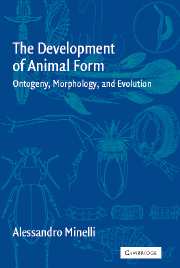Book contents
- Frontmatter
- Contents
- Preface
- Acknowledgements
- 1 The Nature of Development
- 2 Everything Begun to the Service of Development: Cellular Darwinism and the Origin of Animal Form
- 3 Development: Generic to Genetic
- 4 Periodisation
- 5 Body Regions: Their Boundaries and Complexity
- 6 Differentiation and Patterning
- 7 Size Factors
- 8 Axes and Symmetries
- 9 Segments
- 10 Evo-devo Perspectives on Homology
- Summary and Conclusions
- References
- Index
7 - Size Factors
Published online by Cambridge University Press: 10 August 2009
- Frontmatter
- Contents
- Preface
- Acknowledgements
- 1 The Nature of Development
- 2 Everything Begun to the Service of Development: Cellular Darwinism and the Origin of Animal Form
- 3 Development: Generic to Genetic
- 4 Periodisation
- 5 Body Regions: Their Boundaries and Complexity
- 6 Differentiation and Patterning
- 7 Size Factors
- 8 Axes and Symmetries
- 9 Segments
- 10 Evo-devo Perspectives on Homology
- Summary and Conclusions
- References
- Index
Summary
A causal explanation for the striking correlation between miniaturization and novelty may lie in part in the effect of size reduction on the morphogenetic mechanisms of pattern formation, many of which are size dependent.
J. Hanken and D.B. Wake 1993: 507Cell Size Critical for Morphogenesis
Cell size can be deadly critical for morphogenesis. In Drosophila, embryos lacking the product of the string gene do not undergo cell divisions following the thirteenth mitotic cycle. For a while, this defect does not cause any problem. Following cellularisation of the originally syncytial blastoderm, string embryos undergo a noticeable degree of morphogenesis and tissue differentiation. However, at a later stage, they fail to gastrulate, due to the excessive size of their cells which cannot undergo the normal movements necessary for gastrulation (Foe 1989).
A correct cell size, however, is not simply a mechanical requirement for normal development. In a more subtle sense, cell size is often the grain of organic form. Organs or organisms composed of cells of smaller size may attain higher complexity than comparable organs or organisms whose cells are larger. A beautiful example is provided by the variation in cell size and overall complexity of the tectum mesencephali, the main visual centre in amphibians. Frogs with small cells have a tectum with more complex morphology than those with large cells; this is independent of body and brain size.
- Type
- Chapter
- Information
- The Development of Animal FormOntogeny, Morphology, and Evolution, pp. 133 - 141Publisher: Cambridge University PressPrint publication year: 2003



